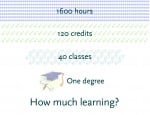Cracking the Credit Hour
CompetencyWorks Blog
 Cracking the Credit Hour from the New American Foundation is a fascinating read. It outlines exactly why higher education needs to make the leap to competency education. It points out the standard unit is in fact not standard at all. It explains why competency education has become such a hot issue in higher education policy circles. It’s a must read.
Cracking the Credit Hour from the New American Foundation is a fascinating read. It outlines exactly why higher education needs to make the leap to competency education. It points out the standard unit is in fact not standard at all. It explains why competency education has become such a hot issue in higher education policy circles. It’s a must read.
The Birth of the Credit Hour: The report explains the emergence of the Carnegie unit, “American secondary schools expanded dramatically around the turn of the 20th century, swelling the ranks of high school graduates. That meant a commensurate rise in the number of students applying to college, which created a dilemma for college admissions officers. It was hard to know what level of preparation, knowledge, and skill was really represented by all the new high school diplomas. In the late 1800s, the National Education Association endorsed the concept of a “standard unit” of time that students spent on a subject as an easy-to-compare measure.” This later became the Carnegie unit as higher education adopted the time-based framework for itself spurred on by Andrew Carnegie’s efforts to establish pensions for college faculty.
By 1938, the Carnegie Foundation had already realized the mistake that had been made. And here we are 74 years later still locked in by an education response to an increase in demand over 100 years ago.
Varying Exchange Rates on the Credit-Hour Currency: The author, Amy Latinen, does a brilliant job in describing how the “standard unit” fails its primary functions. We all know about how inconsistency in curricular goals and grades creates variability in courses based Carnegie unit, hence the Common Core. Latinen points out, “If credit hours truly reflected a standardized unit of learning, they would be fully transferable across institutions…. But colleges routinely reject credits earned at other colleges. Given that only 41 percent of graduates attend a single college, 59 percent attend two or more, and 24 of those percent attend three or more, non-transfer of credits exacts huge costs from students and likely reduces their chance of completing a degree
Emerging Efforts to Measure Student Learning: The report highlights two efforts being developed to measure learning rather than time.
- Degree Qualifications Profile (DQP) ” highlights five key areas (broad, integrative knowledge; applied learning; intellectual skills; specialized knowledge;and civic learning) that should be part of any degree program, and articulates differences in depth and sophistication of each key area as one moves up the degree ladder.” Building on work done in Europe, DQP is currently being tested in more than 30 states and 100 institutions.
- Tuning USA” is a faculty-driven process that also seeks to articulate learning outcomes at the discipline level. This is often less an exercise in creating minimum outcomes than an effort to articulate what is already in practice, allowing groups of experts to collectively fine-“tune” their expectations, and make these expectations transparent to students, other institutions, and employers.
Paths to Innovation: In her recommendation, Latinen makes several meaningful distinction. She highlights that we can continue to use credit hours as a framework while shifting to recognize learning gains based on competencies. This is exactly what NH has done in its K-12 reforms. In addition to investing in innovation, described as experimental sites, Latinen suggests that direct assessment, measuring learning without attention to the credit hour framework, should be explored. K-12 is going to be able to move forward in this area much more easily than higher education simply because students are at a much earlier stage of the learning trajectory.
The alignment between higher education and K-12 around competency education is going to be powerful. Imagine high school students able to just keep moving up their learning path without interruption, building up transferable competency-based college credits while still participating in band or football. Parents are going to be much less concerned about their children’s competitive edge if they can see clear benefits.
However, we need to pay attention that a competency education K-12 system operates around the moral imperative for all students to reach proficiency in core academic areas and the lifelong learning competencies referred to as 21st century skills. Higher education is much more competitive system with the conversation focused more on cost, flexibility, and skill-building for entry into the labor force. We need to learn from higher education as they make the same transition while protecting the moral imperative that is inherent in K-12 competency education.